Comet McNaught Photo Gallery
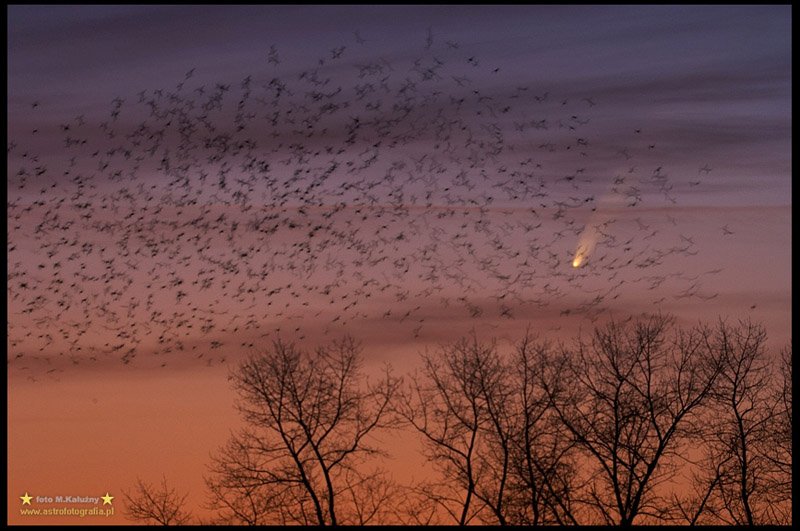

to view BIG / ENLARGED/ high-resolution!!
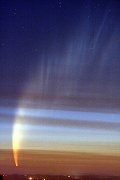
Jamie Newman, Papakura, Auckland, New Zealand Jan. 18, 2007
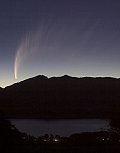
Roberto Solans, Villa La Angostura, Northwestern Patagonia, Argentina. Jan. 18, 2007
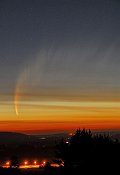
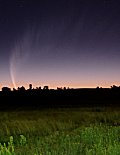
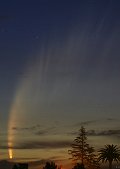

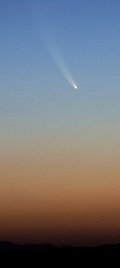
Brendan Dickerson, Windhoek, Namibia, Africa Jan. 18, 2007 -- Beautiful evening, clear skies, no city lights, just up the road from the Max Plank Gamma Array Scope in Namibia.
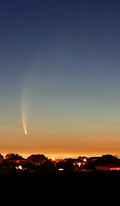
![[Image]](http://www.spaceweather.com/comets/mcnaught/05jan07/Dahle1_med.jpg)
Haakon Dahle, Fjellhamar, Norway Jan. 5, 2007
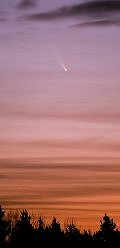
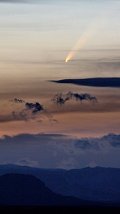

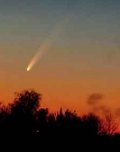
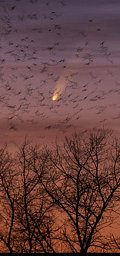
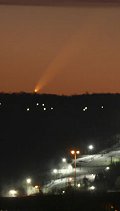
The comet shown a beautiful orange in twilight shortly before it set above Spirit Mountain in Duluth, Minn., where you can see the ski runs lit for nighttime skiing. What a fantastic view! Photo details: Canon Mark II plus the equivalent of a 540mm telephoto lens at ISO 200.
Click to find the comet to the left of the Statue of Liberty. Brooklyn, NY - Brooklyn Heights Promenade James Shanks, Jan. 10, 2007

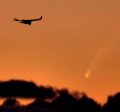
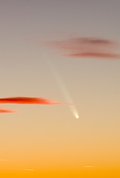
Gerhard Kupfer, Bopfingen, Baden-Warttemberg, Germany Jan. 13, 2007
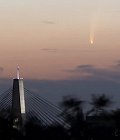
Grahame Kelaher, Sydney, NSW, Australia Jan. 16, 2007 -- Comet McNaught really put on a show for Sydney tonight, estimated mag was -2.5 (+-0.5). It was easily visible on the horizon for about 30 mins after sunset! Photo details: Canon 20D, ISO 200 with a 70-300mm lens, f/5.6, with 2x teleconvertor.
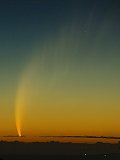
Kevin Crause, Mossel Bay, Western Cape, South Africa Jan. 17, 2007, An incredible naked-eye object last night (17-01-07). First night the comet was visible here due to cloud cover.
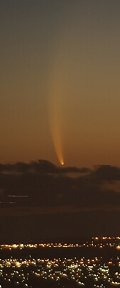
Ben and Vic Levis, Lesmurdie, Western Australia Jan. 17, 2007 -- The comet was a stunning sight from the top of the Darling Range, Lesmurdie, overlooking the south of Perth City Photo details: Canon EOS 1Ds MKII, 400mm f2.8L, 135mm f2L both with 2x tele-converter. Exposure range 1/30 to 3 seconds.
http://photobucket.com/images/search/comet%20mcnaught/

CometMcNaugh , Mont Lagazuoi,Jan. 10, 2007
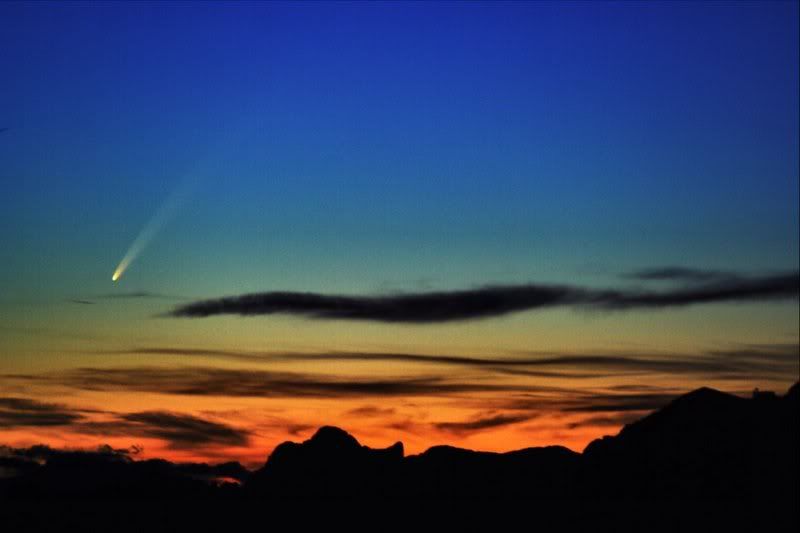
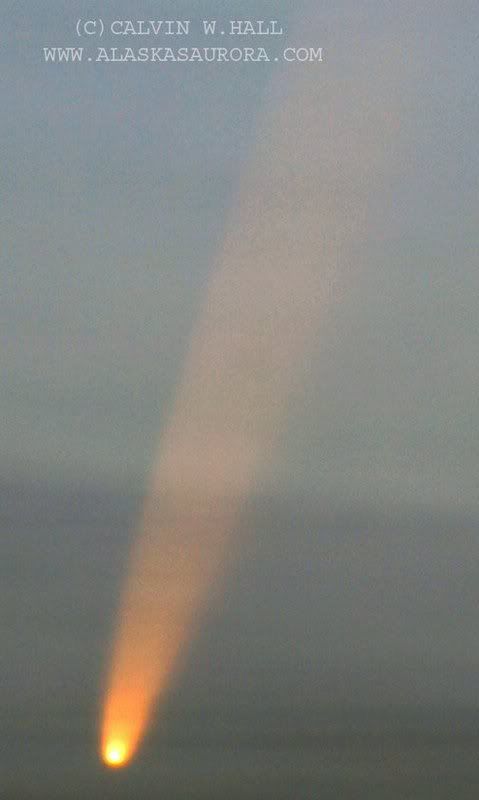
C/2006 P1 (McNaught)--Daily Ephemeris
The following daily ephemeris is from the orbital elements on MPC 58538:Date TT R. A. (2000) Decl. Delta r Elong. Phase m1 m2
2007 01 10 19 31.42 -10 08.5 0.963 0.206 12.1 89.5 -0.9
2007 01 11 19 39.34 -11 43.1 0.920 0.186 10.6 104.6 -1.5
2007 01 12 19 47.55 -13 56.4 0.880 0.174 8.6 121.9 -1.9
2007 01 13 19 55.70 -16 49.5 0.849 0.171 6.6 138.6 -2.0
2007 01 14 20 03.34 -20 12.4 0.828 0.178 5.4 148.4 -1.9
2007 01 15 20 10.22 -23 47.1 0.818 0.193 6.4 145.7 -1.6
2007 01 16 20 16.27 -27 16.6 0.818 0.215 8.7 135.9 -1.1
2007 01 17 20 21.61 -30 30.8 0.826 0.240 11.5 125.1 -0.6
2007 01 18 20 26.38 -33 25.7 0.839 0.268 14.2 115.4 -0.1
2007 01 19 20 30.70 -36 00.9 0.856 0.296 16.7 107.0 0.4
2007 01 20 20 34.68 -38 17.8 0.875 0.326 19.0 99.8 0.8
2007 01 21 20 38.40 -40 18.7 0.896 0.355 21.1 93.6 1.3
2007 01 22 20 41.91 -42 05.6 0.917 0.384 23.0 88.3 1.7
2007 01 23 20 45.25 -43 40.5 0.940 0.414 24.7 83.7 2.0
2007 01 24 20 48.46 -45 05.1 0.962 0.442 26.2 79.6 2.4
2007 01 25 20 51.56 -46 20.9 0.985 0.471 27.7 76.1 2.7
2007 01 26 20 54.57 -47 29.2 1.008 0.499 29.0 72.9 3.0
2007 01 27 20 57.51 -48 31.0 1.030 0.527 30.2 70.1 3.3
2007 01 28 21 00.38 -49 27.1 1.052 0.554 31.3 67.6 3.5
2007 01 29 21 03.19 -50 18.3 1.074 0.581 32.4 65.3 3.8
2007 01 30 21 05.96 -51 05.4 1.096 0.608 33.4 63.2 4.0
2007 01 31 21 08.68 -51 48.7 1.117 0.634 34.4 61.4 4.3
2007 02 01 21 11.36 -52 28.7 1.138 0.660 35.3 59.6 4.5
2007 02 02 21 14.01 -53 05.9 1.158 0.686 36.2 58.1 4.7
2007 02 03 21 16.64 -53 40.6 1.178 0.711 37.0 56.6 4.9
2007 02 04 21 19.23 -54 13.0 1.198 0.736 37.8 55.3 5.1
2007 02 05 21 21.80 -54 43.5 1.217 0.761 38.6 54.0 5.2
2007 02 06 21 24.35 -55 12.2 1.236 0.785 39.4 52.9 5.4
2007 02 07 21 26.87 -55 39.3 1.254 0.809 40.2 51.8 5.6
2007 02 08 21 29.38 -56 05.1 1.272 0.833 40.9 50.8 5.7
Historical Comet Observations by Karen Meech
http://solarsystem.nasa.gov/scitech/display.cfm?ST_ID=205
To primitive man, a comet was something to be feared, a portent of an impending disaster. Because comets brighten relatively rapidly when they get close to the sun, and because bright comets (visible to the naked eye) are relatively rare, comets would appear in the sky suddenly and unexpectedly. In addition, near perihelion, comet tails can extend millions of kilometers in space (making them the largest objects in the solar system), thus depending on the geometry of the orbit, the tail can have a length projected against the sky which is a large fraction of the celestial sphere. In an era where the celestial realm was the realm of the gods, the sudden appearance of an unknown object which dominated the night sky was terrifying.
![[Image]](http://solarsystem.nasa.gov/scitech/images/inset-20040405-205-1.jpg)
In the Greek Era, the nature of the comets was intensely debated, but the theme of fear was prevalent as seen in this cometary quote from the greatest Greek author of antiquity, Homer:
"[The helmut of Achilles shone] like the red star, that from his flaming hair shakes down disease, pestilence, and war" (Iliad, Bk. XIX, 11, 380-3).
![[Image]](http://solarsystem.nasa.gov/scitech/images/inset-20040405-205-7.jpg)
One of the most familiar comets, Halley's comet, played a prominent role in history because of its large nucleus and therefore great brightness and longevity. In 1066 when King Harold was overthrown by William the Conquerer at the Battle of Hastings, the cause of the event seems to have been pegged on a celestial visitor as is shown by the appearance of Halley's comet in the Bayeux Tapestry (left) which chronicles the event. In 1456, on a return passage, Halley's comet was excommunicated as an agent of the devil by Pope Calixtus III, but it didn't do any good - the comet has continued to return! During this same apparition, while Turkish forces were laying seige to Belgrade, the comet was described as a fearsome celestial apparition "with a long tail like that of a dragon" which was perceived by some as being in the form of "a long sword advancing from the west ... " (Moore and Mason, 1984).
According to Chambers (1909), there are only a handful of comets which may be considered to be "remarkable". The list, reproduced below, comprises only 32 comets in the past 1000 years, indicating that we might expect an exceptional comet on average only 3 times per century. These remarkable comets are noteworthy for their extended visibility (including daytime visibility), and their exceptional brightness and spectacular features, which included reddish colors, multiple tails, jets and haloes.
![[Image]](http://solarsystem.nasa.gov/scitech/images/inset-20040405-205-9.jpg)
The Great Comet of 1843 as seen from Kent, England (Chambers, 1909). Because these comets appear suddenly and are seen by a multitude of people, nobody can be claimed as the discoverer. One of the most spectacular historical comets was the Great Comet of 1811 (Flaugergues) which was observed for an unprecedented 17 months. When discovered, it was 5th magnitude and over 2 AU from the sun. The maximum tail length was estimated to be 100 million miles. This comet attracted the attention of Napoleon as presaging his invasion of Russia, yet others wondered "what misfortune does it bring?" (Chambers, 1909).
Comets have seemingly always had a bad reputation, they just seemed to be in the wrong place at the wrong time.
The faithful in Europe prayed for mercy from their enemies in the fifteenth century. And it was many enemies these people had. The Turks were invading and conquering, the devil was running rampant, it seemed no-one was safe. And included in the list of enemies, was a bright comet in the sky. It gave rise to a common prayer back then:
"Lord, save us from the devil,
the Turk, and the comet...
Amen"
When Julius Caesar was assassinated in 44 B.C., there was a bright comet in the sky, that some said foretold of his death, and others said, it carried Caesar's soul into heaven.
In the year 1066, King Harold proposed the comet in the sky at the time, to be an evil omen of things to come. Shortly afterwards, he led his armies into battle, against William the conquerer!
A comet in the sky was blamed for the eruption of Mount Vesuvius in 1631.
A lot of people in London shook their fists at the comet of 1665 as they died of bubonic plague. London was the only major city ravaged by the plague that year. However, elsewhere, when people saw the comet, they were busy moving out of the range of volcanos!
When Comet Halley visited in 1910 it was discovered that the Earth would pass through the comet's tail. When Astronomers mentioned trace amounts of cyanide gas were in the tail (far too sparse to ever have an effect) this got blown way out of proportion. Gas Masks were a hot item in 1910, as were "comet pills" which made one doctor quite rick.
In 1973 the Children of God distributed pamphlets proclaiming that Comet Kohoutek was sent to announce the end of the world. The comet itself was a disappointment, the media had hyped it up a great deal and astronomers had believed it would become very bright as it swung around the sun. No matter that you nearly had to strain your eyes to see it, the cultists still claimed it was the end of the world.
And of course, most recently were the 39 deaths of the Heaven's Gate cult. The cult was inspired by some misinformation from an amateur astronomer, Chuck Shramek of Texas. Shramek photographed the comet and saw what eventually turned out to be a star, but Shramek reported it as a "saturn like object following the comet." The cult's leader decided this object was a spacecraft, long awaited, according to their prophecies. Their actions led to suicide.
It is interesting to note that with Comet Hyakutake there was only a few weeks notice for the comet's appearance. There was no cult surfacing proclaiming doomsday or other horrors. Apparently these things take time to build up, with help from media hype. It is sad though to look back over the centuries and see that superstitions still abound. In spite of the attempts to educate, fear and superstition can still rule some people, and a graceful visit from a celestial object can lead to tragedy. It gives us all a deeper responsibility to teach children not to fear the unknown.
http://starryskies.com/Artshtml/dln/3-98/comet.htmlParanoia and superstition
In many cultures, comets have historically been viewed as bad omens and viewed with great suspicion. Perhaps because of the very long build-up to Hale-Bopp's passage, and its rare size and activity, the comet became the subject of many bizarre beliefs and theories.
In November 1996, amateur astronomer Chuck Shramek of Houston, Texas took a CCD image of the comet, which showed a fuzzy, slightly elongated object nearby. When his computer sky-viewing program did not identify the star, Shramek called the Art Bell radio program to announce that he had discovered a "Saturn-like object" following Hale-Bopp. UFO enthusiasts, such as remote viewing proponent Courtney Brown, soon concluded that there was an alien spacecraft following the comet. In fact, the object was simply an 8.5-magnitude star, SAO141894, which did not appear on Shramek's computer program because the user preferences were set incorrectly. [2] Reportedly, Shramek refused to admit to his mistake when this was pointed out to him.
Later, Art Bell even claimed to have obtained an image of the object from an anonymous astrophysicist who was about to confirm its discovery. However, astronomers Olivier Hainaut and David J. Tholen of the University of Hawaii stated that the alleged photo was an altered copy of one of their own comet images [3].
A few months later, in March 1997, the cult group Heaven's Gate chose the appearance of the comet as a signal for their mass cult suicide. They claimed they were leaving their earthly bodies to travel to the spaceship following the comet.
Credit & Copyright: William R. Dellinges
Explanation: Four years ago, Comet Hale-Bopp was discovered out near Jupiter falling toward the inner Solar System. Two years ago, it provided spectacular pictures as it neared its closest approach to the Sun. Still today, spectacular pictures of the brightest comet of the 1990s are surfacing. Above, Comet Hale-Bopp was photographed in 1997 behind the Superstition Mountains in Arizona. Clearly visible are the comets white dust tail that shines by reflected sunlight, and the blue ion tail that shines by glowing gas. Currently, there are several comets visible from the proper location with a small telescope. A comet visible to the unaided eye appears about once every five years.
2007 January 18
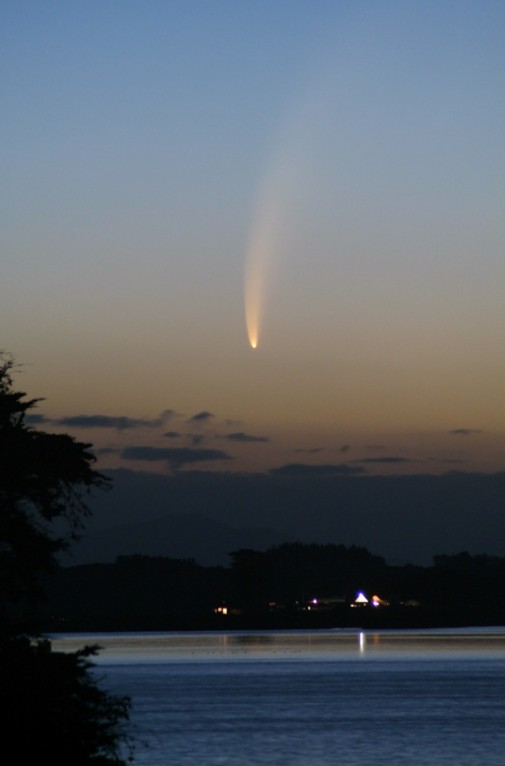 | Credit & Copyright: Noel Munford (Palmerston North Astronomical Society, New Zealand) Explanation: After a remarkable performance in the northern hemisphere, the brightest comet in decades is now showing off in the south. Recorded during evening twilight on January 17, this view features the bright coma and gorgeous, sweeping tail of Comet McNaught (c/2006 P1) over Lake Horowhenua in Levin, a small town on New Zealand's North Island. Astronomer Noel Munford reports that the five second long digital camera exposure comes close to capturing the visual appearance of the comet in a sky coloured by smoke from distant brush fires in Australia. Discovered last summer by R. H. McNaught (Siding Spring Survey), the comet grew impressively bright in early January and has even been sighted in full daylight. In the coming days Comet McNaught will continue to move south, for now a spectacle |
Credit: SECCHI, STEREO, NRL, NASA
Explanation: The brightest comet of recent decades was a surprising first sight for a new camera in space. The Sun Earth Connection Coronal and Heliospheric Investigation (SECCHI) instrument onboard the Solar TErrestrial RElations Observatory (STEREO) satellite had just opened up on January 11 when it snapped the above image of Comet McNaught. Visible was a spectacular view of the ion tail of Comet McNaught being swept away from the Sun by the solar wind in filamentary rays. The comet tail is seen to extend at least seven degrees across the above image, while the central coma is so bright it saturates. Comet McNaught is now reportedly so bright that it is visible even in broad daylight by blocking out the Sun with your hand. Comet McNaught has rounded the Sun and will slowly fade away for observers in Earth's Southern Hemisphere as it recedes from the Sun.
Credit & Copyright: Juan Casado (skylook.net)
Credit & Copyright: Andrzej Sawow
Credit & Copyright: Jens Hackmann
Credit & Copyright: Michael Jager and Gerald Rhemann
Explanation: Early morning risers with a clear and unobstructed eastern horizon can enjoy the sight of Comet McNaught (C/2006 P1) in dawn skies over the next few days. Discovered in August by R. H. McNaught (Siding Spring Survey) the comet has grown bright enough to see with the unaided eye but will soon be lost in the glare of the Sun. Still, by January 11 sun-staring spacecraft SOHO should be able to offer web-based views as the comet heads toward a perihelion passage inside the orbit of Mercury. This image captures the new naked-eye comet at about 2nd magnitude in twilight skies near sunset on January 3rd. After rounding the Sun and emerging from the solar glare later this month, Comet McNaught could be even brighter.








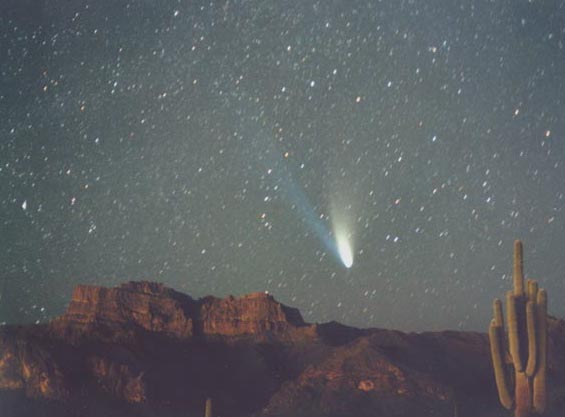

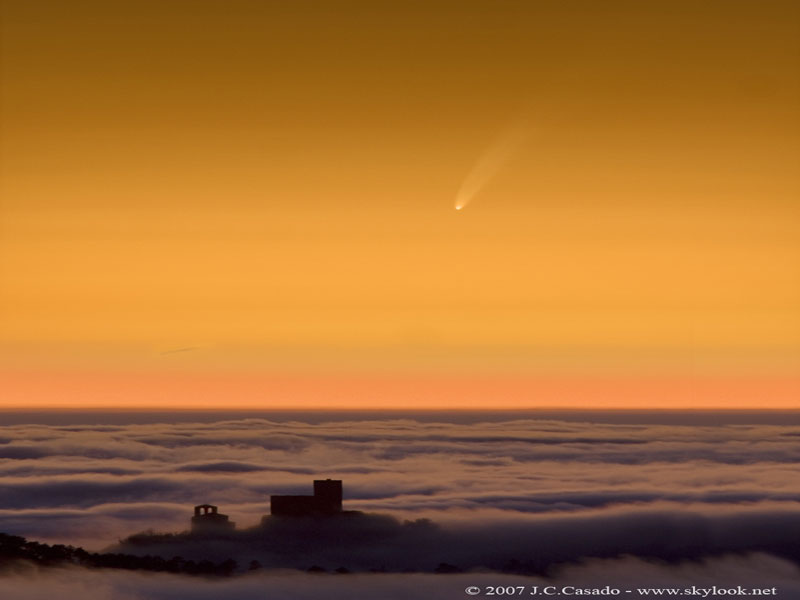
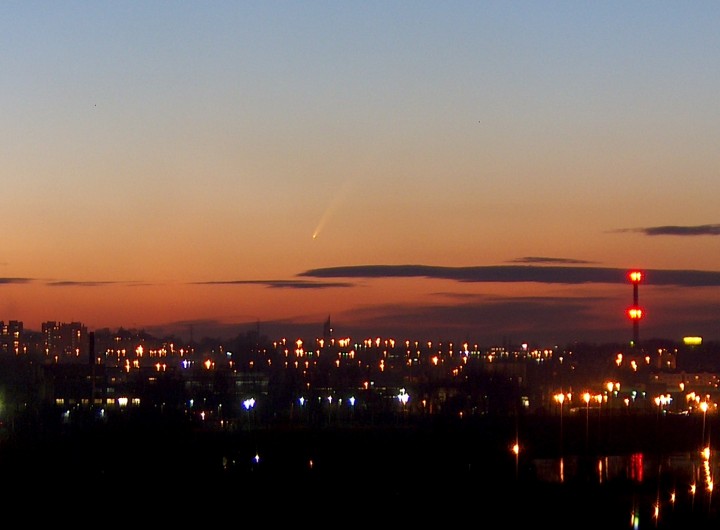

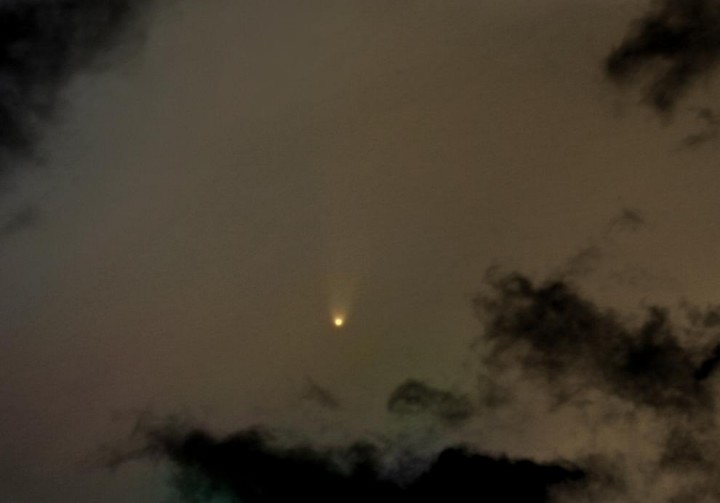
 Earth's magnetic field:
Earth's magnetic field:


0 Comments:
Post a Comment
<< Home